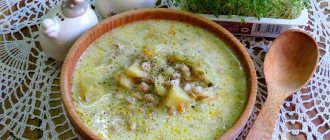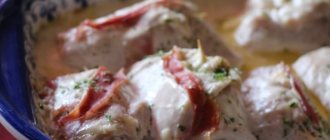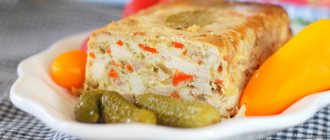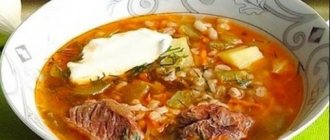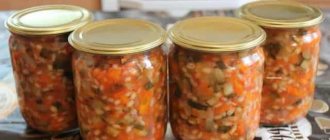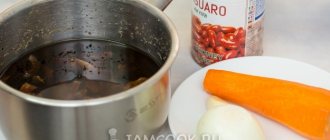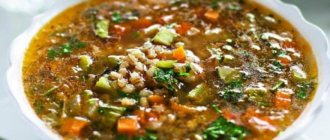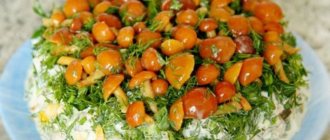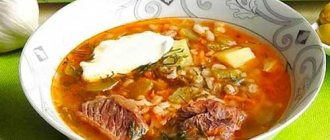Bulgur is a grain that is prepared in a special way. The wheat is scalded, then dried, and then crushed. This cereal is very popular in the Middle East, the Balkans and India.
Bulgur contains many vitamins and microelements, and in terms of fiber, this grain is not inferior to buckwheat.
Porridges are cooked from bulgur, pilaf and salads are prepared. This grain is also added to soups. Bulgur with mushrooms can be an independent vegetarian dish, or can be prepared as a side dish for meat or poultry.
Bulgur with mushrooms and onions
This dish can be prepared as a side dish for chicken or stew. You can also eat it during Lent as a hearty, high-calorie dinner.
Ingredients:
- dried mushrooms – 50 gr.;
- bulgur – 1 cup;
- vegetable broth - 2 cups;
- onions – 1-2 pcs.;
- greens – 1-2 sprigs;
- salt, spices.
Preparation:
- Soak dry porcini mushrooms in warm water for about half an hour, and then cook until soft with the addition of salt.
- The onion needs to be peeled, chopped into half rings and fried in vegetable oil.
- Add the boiled mushrooms and simmer over low heat for a few minutes.
- Mushroom broth is useful for preparing cereals.
- Add bulgur to the frying pan and fill with mushroom broth.
- Taste, add salt if necessary and add spices. This can be ground black pepper, coriander or spices that you like best.
- Bring to a boil and reduce heat to low.
- Cover with a lid and cook for about another quarter of an hour.
The finished dish can be additionally sprinkled with aromatic oil and sprinkled with chopped herbs.
Recipe Bulgur with mushrooms. Calorie, chemical composition and nutritional value.
Nutritional value and chemical composition of “Bulgur with mushrooms”.
The table shows the nutritional content (calories, proteins, fats, carbohydrates, vitamins and minerals) per 100 grams of edible portion.
| Nutrient | Quantity | Norm** | % of the norm in 100 g | % of the norm in 100 kcal | 100% normal |
| Calorie content | 71.2 kcal | 1684 kcal | 4.2% | 5.9% | 2365 g |
| Squirrels | 2.6 g | 76 g | 3.4% | 4.8% | 2923 g |
| Fats | 0.9 g | 56 g | 1.6% | 2.2% | 6222 g |
| Carbohydrates | 14.2 g | 219 g | 6.5% | 9.1% | 1542 g |
| Alimentary fiber | 3.4 g | 20 g | 17% | 23.9% | 588 g |
| Water | 144.3 g | 2273 g | 6.3% | 8.8% | 1575 g |
| Ash | 0.362 g | ~ | |||
| Vitamins | |||||
| beta carotene | 0.001 mg | 5 mg | 500000 g | ||
| Lutein + Zeaxanthin | 36.667 mcg | ~ | |||
| Vitamin B1, thiamine | 0.044 mg | 1.5 mg | 2.9% | 4.1% | 3409 g |
| Vitamin B2, riboflavin | 0.021 mg | 1.8 mg | 1.2% | 1.7% | 8571 g |
| Vitamin B4, choline | 4.68 mg | 500 mg | 0.9% | 1.3% | 10684 g |
| Vitamin B5, pantothenic | 0.185 mg | 5 mg | 3.7% | 5.2% | 2703 g |
| Vitamin B6, pyridoxine | 0.07 mg | 2 mg | 3.5% | 4.9% | 2857 g |
| Vitamin B9, folates | 5.49 mcg | 400 mcg | 1.4% | 2% | 7286 g |
| Vitamin C, ascorbic acid | 1.1 mg | 90 mg | 1.2% | 1.7% | 8182 g |
| Vitamin E, alpha tocopherol, TE | 0.113 mg | 15 mg | 0.8% | 1.1% | 13274 g |
| Vitamin H, biotin | 0.099 mcg | 50 mcg | 0.2% | 0.3% | 50505 g |
| Vitamin K, phylloquinone | 0.3 mcg | 120 mcg | 0.3% | 0.4% | 40000 g |
| Vitamin RR, NE | 0.9073 mg | 20 mg | 4.5% | 6.3% | 2204 g |
| Niacin | 0.022 mg | ~ | |||
| Macronutrients | |||||
| Potassium, K | 87.58 mg | 2500 mg | 3.5% | 4.9% | 2855 g |
| Calcium, Ca | 10.74 mg | 1000 mg | 1.1% | 1.5% | 9311 g |
| Magnesium, Mg | 29.21 mg | 400 mg | 7.3% | 10.3% | 1369 g |
| Sodium, Na | 3.57 mg | 1300 mg | 0.3% | 0.4% | 36415 g |
| Sera, S | 7.48 mg | 1000 mg | 0.7% | 1% | 13369 g |
| Phosphorus, Ph | 56.4 mg | 800 mg | 7.1% | 10% | 1418 g |
| Chlorine, Cl | 3.22 mg | 2300 mg | 0.1% | 0.1% | 71429 g |
| Microelements | |||||
| Aluminium, Al | 44 mcg | ~ | |||
| Bor, B | 22 mcg | ~ | |||
| Iron, Fe | 0.501 mg | 18 mg | 2.8% | 3.9% | 3593 g |
| Yod, I | 0.33 mcg | 150 mcg | 0.2% | 0.3% | 45455 g |
| Cobalt, Co | 0.55 mcg | 10 mcg | 5.5% | 7.7% | 1818 |
| Manganese, Mn | 0.5338 mg | 2 mg | 26.7% | 37.5% | 375 g |
| Copper, Cu | 65.93 mcg | 1000 mcg | 6.6% | 9.3% | 1517 g |
| Nickel, Ni | 0.33 mcg | ~ | |||
| Rubidium, Rb | 52.4 mcg | ~ | |||
| Selenium, Se | 0.383 mcg | 55 mcg | 0.7% | 1% | 14360 g |
| Fluorine, F | 36.74 mcg | 4000 mcg | 0.9% | 1.3% | 10887 g |
| Chromium, Cr | 0.22 mcg | 50 mcg | 0.4% | 0.6% | 22727 g |
| Zinc, Zn | 0.4152 mg | 12 mg | 3.5% | 4.9% | 2890 g |
| Digestible carbohydrates | |||||
| Starch and dextrins | 0.011 g | ~ | |||
| Mono- and disaccharides (sugars) | 1 g | max 100 g | |||
| Glucose (dextrose) | 0.143 g | ~ | |||
| Sucrose | 0.715 g | ~ | |||
| Fructose | 0.132 g | ~ | |||
| Essential amino acids | 0.031 g | ~ | |||
| Arginine* | 0.113 g | ~ | |||
| Valin | 0.095 g | ~ | |||
| Histidine* | 0.049 g | ~ | |||
| Isoleucine | 0.08 g | ~ | |||
| Leucine | 0.144 g | ~ | |||
| Lysine | 0.063 g | ~ | |||
| Methionine | 0.033 g | ~ | |||
| Methionine + Cysteine | 0.002 g | ~ | |||
| Threonine | 0.063 g | ~ | |||
| Tryptophan | 0.034 g | ~ | |||
| Phenylalanine | 0.101 g | ~ | |||
| Phenylalanine+Tyrosine | 0.008 g | ~ | |||
| Nonessential amino acids | 0.073 g | ~ | |||
| Alanin | 0.079 g | ~ | |||
| Aspartic acid | 0.113 g | ~ | |||
| Glycine | 0.087 g | ~ | |||
| Glutamic acid | 0.671 g | ~ | |||
| Proline | 0.216 g | ~ | |||
| Serin | 0.1 g | ~ | |||
| Tyrosine | 0.063 g | ~ | |||
| Cysteine | 0.049 g | ~ | |||
| Sterols (sterols) | |||||
| beta sitosterol | 0.667 mg | ~ | |||
| Saturated fatty acids | |||||
| Saturated fatty acids | 0.1 g | max 18.7 g | |||
| 8:0 Caprylic | 0.002 g | ~ | |||
| 16:0 Palmitinaya | 0.12 g | ~ | |||
| 18:0 Stearic | 0.019 g | ~ | |||
| 20:0 Arakhinovaya | 0.006 g | ~ | |||
| Monounsaturated fatty acids | 0.475 g | min 16.8 g | 2.8% | 3.9% | |
| 16:1 Palmitoleic | 0.012 g | ~ | |||
| 18:1 Oleic (omega-9) | 0.46 g | ~ | |||
| 20:1 Gadoleic (omega-9) | 0.003 g | ~ | |||
| Polyunsaturated fatty acids | 0.171 g | from 11.2 to 20.6 g | 1.5% | 2.1% | |
| 18:2 Linolevaya | 0.166 g | ~ | |||
| 18:3 Linolenic | 0.004 g | ~ | |||
| Omega-6 fatty acids | 0.2 g | from 4.7 to 16.8 g | 4.3% | 6% |
The energy value of Bulgur with mushrooms is 71.2 kcal.
Primary Source: Created in the application by the user. Read more.
** This table shows the average levels of vitamins and minerals for an adult. If you want to know the norms taking into account your gender, age and other factors, then use the “My Healthy Diet” application.
Bulgur with mushrooms and vegetables
A fragrant and healthy lean dish can be prepared by adding this grain to stewed vegetables.
Ingredients:
- champignons – 350 gr.;
- bulgur – 1 cup;
- water – 2 glasses;
- onion – 1 pc.;
- carrots – 1 pc.;
- tomatoes – 2-3 pcs.;
- oil – 70 ml;
- salt, spices.
Preparation:
- Fresh champignons need to be washed, cut into thin slices and fried in oil.
- When all the liquid from the mushrooms has evaporated, add finely chopped onion to the pan.
- After some time, add carrots, which have been cut into small cubes.
- Pour in the washed bulgur, add water. Salt and add dried herbs and spices.
- Simmer over low heat, covered, until the cereal is ready.
- The tomatoes must first be peeled and then cut into thin slices. Fry in a separate frying pan.
- Add them to the dish when all other ingredients are almost ready.
- Stir, taste and add salt or spices if necessary.
- Simmer for a few more minutes and serve.
Bulgur with mushrooms, onions and carrots: recipes in a saucepan, in a frying pan, in a slow cooker
Bulgur has long ceased to be in short supply in our country. It can be purchased at almost all grocery stores. However, not all of our compatriots still know how to cook porridge from this cereal correctly. Knowing and taking into account a number of important points, even a novice cook can cope with this task, since it is not difficult.
- Bulgur comes in different sizes. The smallest grain resembles semolina; it is added to minced meat or dough, but is not used for preparing side dishes. The most versatile is medium-sized bulgur, which is suitable for both first and second courses. Large bulgur is often used for pilaf, as this dish requires a long preparation.
- Many of our compatriots are accustomed to washing and sorting any cereal before cooking. Out of habit, they do the same with bulgur. In fact, when preparing it, wheat grains are not only crushed, but also steamed, so there is no need to wash this cereal. Its small size makes it pointless to try to sort through the cereal. It is a much better idea to toast the bulgur before frying, as this manipulation allows you to emphasize its inherent nutty notes. If you rinse the bulgur before cooking, nothing bad will happen, but it is not necessary.
- Bulgur can be prepared with any mushrooms, but champignons or boletus mushrooms are more often used, since they do not require lengthy preliminary preparation. If you are dealing with dried mushrooms, you need to soak them first. Whether to defrost frozen mushrooms depends on the recipe. If they are added at the end of cooking, then this must be done. In other cases, defrosting is desirable, but not necessary.
- When preparing bulgur with onions, carrots and mushrooms, the vegetables are usually fried. Do this before adding bulgur. Sometimes mushrooms are fried along with vegetables.
- When cooking bulgur, 2 cups of water per cup of cereal are usually used, but this ratio can be changed if the cereal is small or if the dish contains a lot of juicy vegetables.
You can cook bulgur with mushrooms, carrots and onions in a saucepan, cauldron, frying pan, or slow cooker. The cooking method does not greatly affect the technological process, but still, to obtain the expected result, it is advisable not to deviate from the recommendations accompanying a specific recipe.
Bulgur with mushrooms, onions and carrots in a pan
Compound:
- bulgur – 0.45 kg;
- dried white mushrooms – 150 g;
- carrots – 0.2 kg;
- onions – 0.2 kg;
- butter – 50 g;
- refined vegetable oil – 50 ml;
- fresh parsley – 50 g;
- soy sauce – 50 ml;
- water – 1 l;
- salt, pepper, cumin - to taste.
Cooking method:
- Cover the mushrooms with water and leave for an hour or two so that they regain their shape and volume. Rinse them. Cut into large pieces.
- Boil the prescribed amount of water. Pour it over the bulgur. Cover with a lid and leave for half an hour.
- Scrub and wash the carrots. Dry it with a paper towel. Cut into cubes about 7-6 mm in size, or even smaller.
- Remove the peel and cut the onion into small cubes.
- Pour vegetable oil into a thick-bottomed pan, add onions and carrots. Fry them until soft. Add mushrooms and fry them for 10 minutes along with vegetables.
- Add bulgur to mushrooms and vegetables. Cover the pan with a lid. Simmer the food over low heat for 15-20 minutes. 10 minutes before readiness, pour finely chopped parsley into the pan, add butter, pour in soy sauce, and stir.
The dish according to this recipe will turn out appetizing and aromatic. According to the same recipe, it can be prepared in a cauldron.
Bulgur with mushrooms, carrots and onions in a frying pan
Compound:
- bulgur – 0.2 kg;
- carrots – 100 g;
- onions – 100 g;
- water – 0.4 l;
- champignons – 0.2 kg;
- salt, seasonings - to taste;
- refined vegetable oil - how much will be needed.
Cooking method:
- Boil the water - you will need it hot.
- Wash the champignons, dry with a napkin, cut into thin slices.
- Peel the carrots, rinse, dry with a napkin. Grind the vegetable using a large-hole grater.
- Peel the onion and finely chop it.
- Heat vegetable oil in a deep frying pan and add chopped vegetables. Fry them until golden brown.
- Add cereal, pour boiling water. Cover the pan with a lid. Reduce heat and cook for 15 minutes.
- Stir, salt and pepper. Add mushrooms, stir again.
- Continue cooking uncovered for 10 to 15 minutes, stirring frequently, until there is no excess liquid left in the pan.
The recipe for this dish is simple, but the dish turns out tasty and aromatic. It is good both as a side dish and as an independent snack. This recipe will appeal to vegetarians, as this dish contains no animal products.
Bulgur with mushrooms, carrots and onions in a slow cooker
Compound:
- bulgur – 0.25 kg;
- champignons – 0.25 kg;
- water – 0.5 l;
- onions – 0.2 kg;
- carrots – 100 g;
- salt, seasonings for pilaf - to taste;
- refined vegetable oil – 60 ml.
- After washing and drying the champignons, cut into large strips.
- Peel the carrots and cut them into quartered circles about half a centimeter thick.
- Peel the onions and cut into large cubes or quarter rings.
- Pour oil into the multicooker bowl. Start the appliance in baking mode for 30-35 minutes.
- Place the onion in the slow cooker, after 5 minutes add the carrots, after another 5 minutes add the mushrooms. Fry the foods together for 15-20 minutes until excess moisture has evaporated.
- Add bulgur. Stir. Wait for the program to complete.
- Add salt, spices, hot water. Stir. Start the multicooker by activating the “Pilaf” program. Wait for it to complete. You can cook in other modes for cooking cereal dishes, as well as in the “Stew” mode. If necessary, set the time, specify 30-40 minutes.
We invite you to familiarize yourself with the benefits of dried porcini mushrooms
The dish prepared according to this recipe resembles vegetarian pilaf. It is served separately or as a side dish for meat snacks.
Despite the fact that dishes made from bulgur, mushrooms, onions and carrots have almost identical composition, they have different organoleptic qualities. The taste of the finished dish is affected by the ratio of products, the seasonings used, and the cooking technology. This makes it possible to diversify the daily menu.
Source: https://blu4mykts.ru/bulgur-gribami-lukom/
Bulgur with mushrooms and chickpeas
A real oriental dish can be prepared from bulgur and large peas, popular in all eastern countries.
Ingredients:
- shiitake – 200 gr.;
- bulgur – 1 cup;
- chickpeas – 1/2 cup;
- onion – 1 pc.;
- garlic – 2-3 cloves;
- oil – 70 ml;
- salt, spices, herbs.
Preparation:
- The chickpeas must be washed and soaked in cold water overnight.
- In the morning, rinse the peas again, add enough water and cook until tender for about an hour.
- Taste, add salt and add hot water. Cook for about another half hour.
- Rinse the bulgur and cook, adding two glasses of water.
- Peel the onion and garlic, cut the onion into cubes, and cut the garlic very finely.
- Wash the mushrooms and chop into arbitrary thin slices.
- Heat a frying pan with olive oil, fry the onions, and then add the mushrooms.
- Add the garlic and cook for a few more minutes.
- Then add bulgur and chickpeas.
- Stir, season with salt and ground pepper.
Before serving, sprinkle the dish with lemon juice and sprinkle with fresh herbs.
Cooking according to the recipe:
- Preheat the oven to 175°C. Place the bulgur in a heatproof bowl. Pour broth and 1.5 tbsp into the pan. water and bring to a boil. Pour the boiling broth over the bulgur and leave for 20 minutes to absorb the liquid.
- Meanwhile, prepare the vegetables: Cut off the top third of the peppers. Remove the seeds and membranes to create bowls. Cut the tops into cubes. Cut a third of the zucchini lengthwise so that the seeds are visible. Scoop them out and make zucchini boats. Cut the cut parts into cubes. Cut the tomatoes in half and scoop out the seeds and membranes to create cups.
- Heat oil in a large sauté pan over moderate heat. Add chopped onion and fry until translucent. Then add chopped peppers, zucchini, mushrooms and garlic. Salt and pepper the vegetables. Cook until tender, about 10 minutes. If necessary, drain the liquid from the prepared vegetables and add them to the prepared bulgur.
- Salt the inside of the vegetable bowls. Fill them with the bulgur filling and place in a shallow baking dish. Cover with foil and bake for 45 minutes. Then remove the foil and sprinkle the vegetables with grated Parmesan. Bake for another 10 minutes or until the cheese is melted and browned.
Categories:
recipe / Stuffed dishes / Summer dishes / Calorie content of ready-made dishes / Main courses / Vegetables and mushrooms / Appetizers / Vegetable snacks / Melissa d'Arabian
Bulgur with champignons
- Share
- Likes 0
| Bulgur – 200 grams | Champignons – 200 grams | Carrots – 1 piece (medium) | Onion – 1 piece (medium) | Water – 400 milliliters | Salt - to taste | Ground black pepper - to taste | Ghee butter – 20 grams You can use any you prefer to cook with |
Oh, bulgur. A favorite of oriental cuisine.
- 35 minutes Serves 4 Easy
This recipe describes the preparation of a very tasty and nutritious dish, using grains and mushrooms that are unusual for our territory.
